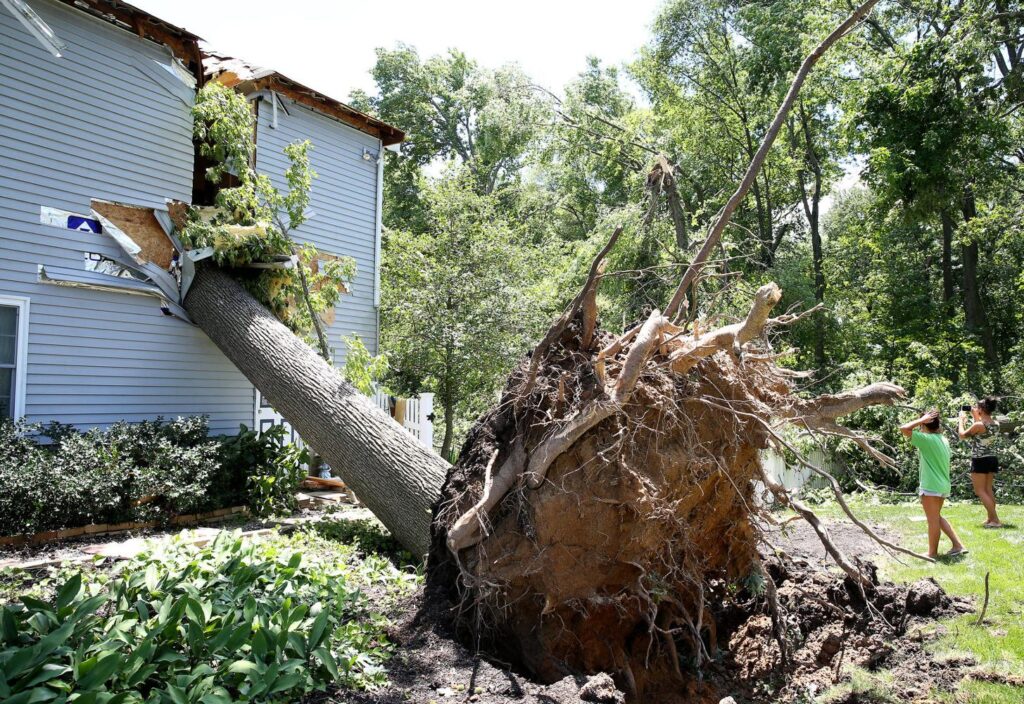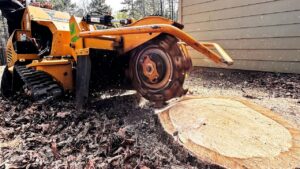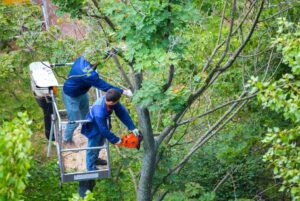Storms can cause significant damage across the United States, impacting homes, businesses, and public spaces. High winds, heavy rains, hail, and lightning are common storm elements that can result in fallen trees, broken branches, and uprooted trees that pose immediate hazards. In such situations, emergency tree removal services play a critical role in quickly addressing these dangers, ensuring public safety, and preventing further property damage. These services are available 24/7, providing rapid response to emergencies caused by severe weather conditions.
Emergency tree removal professionals are equipped with specialized tools and the expertise to safely and efficiently remove hazardous trees and debris. They assess the extent of the damage, develop a removal plan, and execute it with safety as the top priority. By doing so, they not only restore safety but also help minimize the disruption to daily life. With unpredictable weather patterns becoming more frequent, the demand for storm damage and emergency tree removal services continues to grow across the USA.
Areas Most Affected by Storm Damage in the USA
In the USA, certain regions are more prone to storm damage due to their geographical location and climate patterns. The southeastern states, including Florida, Georgia, Alabama, Louisiana, and the Carolinas, are particularly vulnerable to hurricanes and tropical storms. These regions experience powerful winds, heavy rainfall, and tornadoes that often result in extensive tree damage. The Gulf Coast, including Texas, also faces similar threats during hurricane season, making these areas hotspots for storm damage.
Additionally, the Midwest and Great Plains are known for severe thunderstorms and tornadoes, which can cause widespread tree damage. States like Oklahoma, Kansas, Missouri, and parts of Illinois frequently deal with destructive weather that can uproot trees and damage infrastructure. In the Northeast, strong Nor’easters bring heavy snow, ice, and wind, which can weigh down trees and cause branches to snap or trees to fall. The Pacific Northwest also faces challenges with powerful windstorms, particularly in Washington and Oregon, where large, mature trees are common. These regions rely heavily on emergency tree removal services to address storm-related hazards swiftly.

Key Areas Prone to Storm Damage:
- Southeast U.S. (Florida, Georgia, Alabama, Louisiana, the Carolinas):
- Highly susceptible to hurricanes and tropical storms.
- Frequent occurrences of heavy rainfall, high winds, and tornadoes.
- Notable damage includes uprooted trees, broken branches, and power outages
Gulf Coast (Texas, Louisiana):
- Directly impacted by hurricanes during the peak season from June to November.
- Vulnerable to flooding, strong winds, and severe tree damage.
Midwest and Great Plains (Oklahoma, Kansas, Missouri, Illinois):
- Known as Tornado Alley, these areas experience frequent tornadoes and severe thunderstorms.
- Common storm damage includes fallen trees, broken branches, and property damage from high winds.
Northeast U.S. (New York, New Jersey, Massachusetts):
- Affected by Nor’easters, which bring heavy snow, ice, and strong winds.
- Trees can suffer from ice accumulation, leading to broken limbs and toppled trunks.
Pacific Northwest (Washington, Oregon):
- Regular windstorms and heavy rains impact these regions.
- Mature trees, especially evergreens, are often damaged or uprooted by strong winds.
These areas consistently experience significant storm damage, making emergency tree removal services a critical component of storm response efforts.
Most Affected Time/Season for Storm Damage & Emergency Tree Removal Services in the USA
Storm damage is not confined to a single season, but certain times of the year see a higher incidence of severe weather, leading to increased demand for emergency tree removal services. The most active season for storm damage is typically the late spring to early fall, aligning with hurricane and tornado seasons.
Hurricane Season (June to November): The Atlantic hurricane season runs from June 1 to November 30, with the peak occurring from August to October. Coastal areas along the Gulf of Mexico, the Atlantic Coast, and the Southeastern US experience the highest frequency of hurricanes and tropical storms during this period. The powerful winds and heavy rains from these storms often lead to significant tree damage, necessitating emergency tree removal services.
Tornado Season (March to June): Tornadoes are most common in the spring and early summer, especially in the Central Plains and Midwest regions, known as Tornado Alley. This period sees frequent thunderstorms capable of producing tornadoes, which can cause widespread destruction, including uprooted trees and large branches that pose hazards.
Winter Storms (December to March): In the Northern and Northeastern US, winter storms are a major cause of tree damage. Heavy snow, ice accumulation, and strong winds can cause branches to break or entire trees to fall, creating dangerous situations. Ice storms are particularly damaging as the weight of the ice can cause severe stress on trees.
Summer Storms (May to September): In many parts of the country, summer storms bring strong winds, hail, and lightning, all of which can cause tree damage. These storms are often sudden and intense, requiring immediate response to clear fallen trees and debris.
How Can the Government Help with Tree Removal for Storm Damage & Emergency Tree Removal Services in the USA
The government plays a vital role in supporting communities affected by storm damage, including assistance with emergency tree removal. There are several ways in which federal, state, and local governments can help:
- Funding and Grants: The Federal Emergency Management Agency (FEMA) provides financial assistance to individuals and communities impacted by severe storms. This includes funds for debris removal, which can cover the costs associated with emergency tree removal. Additionally, state and local governments may offer grants or low-interest loans to help property owners cover the expenses of storm damage cleanup, including tree removal.
- Public Works and Municipal Services: Local governments often have public works departments equipped to handle emergency tree removal in public spaces such as roads, parks, and sidewalks. These services are crucial in the immediate aftermath of a storm to ensure that public areas are safe and accessible.
- Collaboration with Private Contractors: In severe cases, governments may contract private tree removal companies to assist with the large volume of debris. By partnering with certified arborists and professional tree services, governments can expedite the removal process, reducing the risk of further accidents or delays in recovery.
- Community Awareness and Preparedness Programs: Governments can play a proactive role by educating communities about tree maintenance and storm preparedness. Programs that encourage regular tree inspections, pruning, and removal of dead or hazardous trees can significantly reduce the risk of storm damage. Additionally, providing guidelines on how to handle tree damage and access emergency services can help residents respond effectively during a storm.
- Regulatory Support: Governments can implement regulations that require utility companies to regularly maintain trees near power lines, reducing the likelihood of power outages during storms. They can also enforce building codes that consider tree placement and the potential impact of storms, which can help mitigate risks.
Which Trees Are Most Prone to Storm Damage?
Certain tree species are more vulnerable to storm damage due to their physical characteristics. Trees with shallow root systems, such as silver maples and willows, are more likely to be uprooted in high winds. Fast-growing species like Bradford pears are prone to splitting and breaking under pressure. Additionally, older or diseased trees, regardless of species, are at higher risk of storm damage due to weakened structures.
Senior Benefits of Professional Tree Removal Services
Opting for professional tree removal services offers several benefits, particularly for senior citizens who may be more vulnerable during storm damage situations:
- Safety: Seniors can avoid the physical strain and danger of attempting tree removal on their own. Professionals have the equipment and experience to handle hazardous trees safely.
- Peace of Mind: Knowing that experts are handling the situation can reduce stress and provide reassurance during a chaotic time.
- Reduced Risk of Property Damage: Professional services are skilled at minimizing additional damage to property, which can be a significant concern for seniors on fixed incomes.
Step-by-Step Guide to Safely Addressing Storm Damage and Emergency Tree Removal
Step 1: Assess the Situation Safely: After a storm, assess the damage from a safe distance. Look for downed power lines, leaning trees, or large broken branches that pose immediate threats.
Step 2: Contact Emergency Services: For immediate hazards, such as trees blocking roads or endangering structures, contact local emergency services or the designated emergency tree removal service at 877-398-6469.
Step 3: Avoid DIY Removal: Avoid attempting to remove large trees or branches yourself, especially if they are near power lines or structures. The risk of injury is high without the proper equipment and expertise.
Step 4: Hire Certified Professionals: Look for tree removal services with certified arborists who can provide a thorough assessment and safely execute the removal process.
Step 5: Follow Safety Protocols: Ensure that the removal team follows safety protocols, including using the appropriate protective gear, securing the work area, and properly disposing of debris.
Step 6: Inspect for Additional Hazards: After the removal, inspect the surrounding area for other potential hazards, such as damaged trees that could pose future risks.
Step 7: Plan for Future Prevention: Consider having other trees on your property inspected and maintained to prevent future storm damage. Regular pruning and removal of weak or diseased trees can greatly reduce the risk.
Additional Points to Consider
- Insurance Coverage: Check your homeowner’s insurance policy to see if it covers tree removal costs due to storm damage. Many policies provide coverage for debris removal, including fallen trees.
- Community Support: In the aftermath of severe storms, community groups and volunteer organizations often assist with cleanup efforts. Reach out to local groups that may offer support for those in need.
Storm damage and emergency tree removal services are critical in protecting lives, property, and restoring normalcy in the aftermath of severe weather. By understanding the risks, preparing in advance, and knowing how to access the right services, individuals and communities can better navigate these challenging situations.




